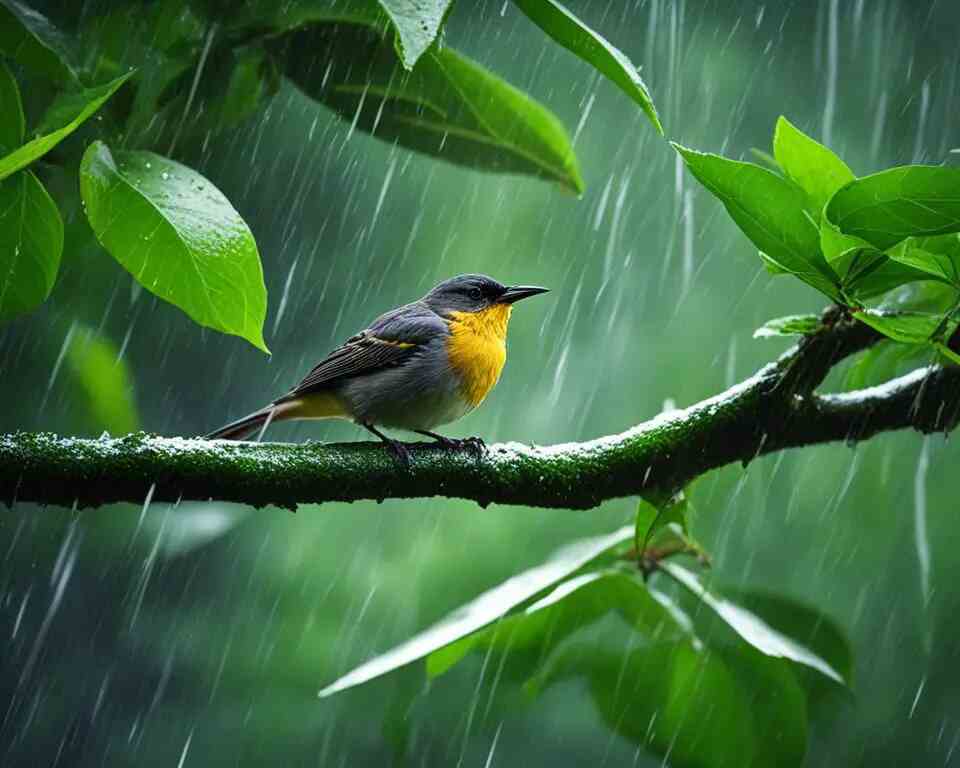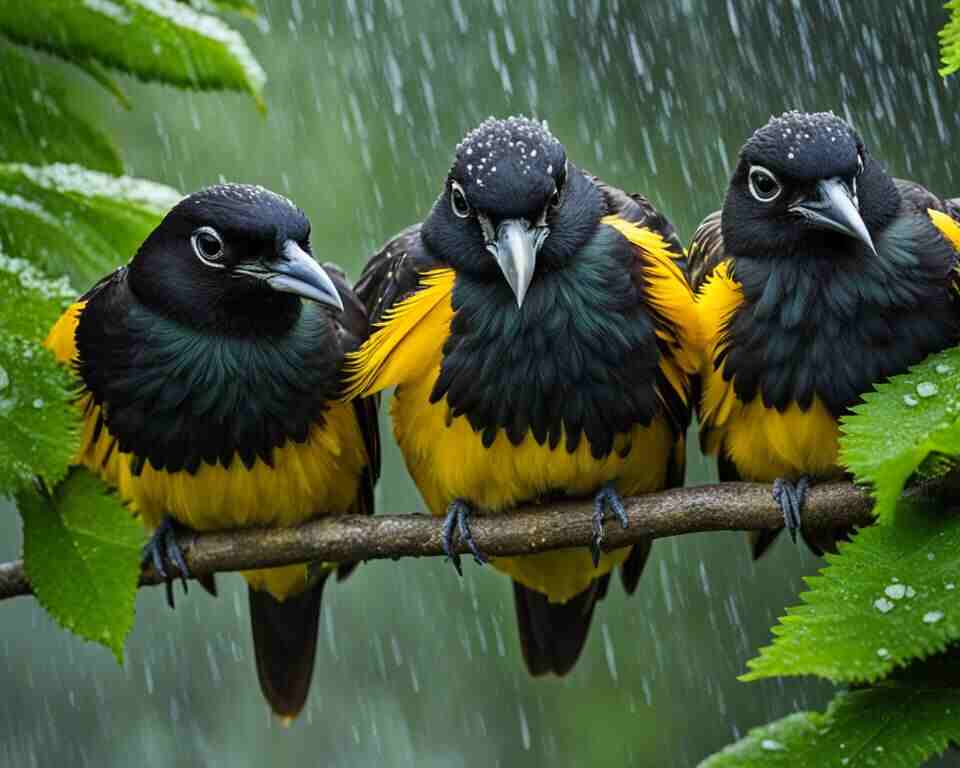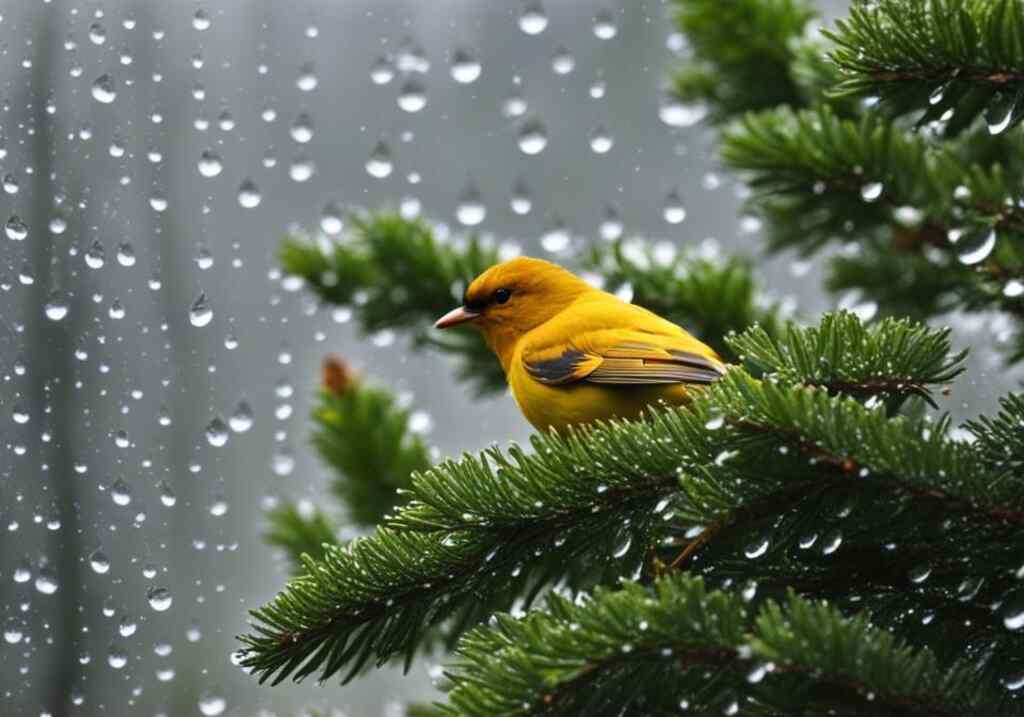Have you ever wondered where do birds go when it rains? Do they go to seek shelter? Birds may temporarily take cover under shrubs and bushes, but eventually, they need to venture out in the open to find food.
With their waterproof feathers, rain slides off their bodies, and they can even preen their feathers with oil for added protection. But how do they adapt and protect themselves in heavy rain?
Table of Contents
- 1 Key Takeaways:
- 2 Why Birds Seek Shelter during Rainy Weather
- 3 How Birds Adapt and Protect Themselves in Rain
- 4 Bird Behavior and Shelter during Rain
- 5 Impact of Rain on Bird Habitat
- 6 Bird Behavior and Rain Patterns
- 7 Rain and Bird Migration: Exploring the Relationship
- 8 Supporting Birds during Rainy Weather
- 9 Conclusion
- 10 FAQs:
- 10.1 How do birds protect themselves from rain?
- 10.2 Why do birds seek shelter during rainy weather?
- 10.3 How can I provide shelter for birds during rainy weather?
- 10.4 How does rain impact bird habitats?
- 10.5 What behaviors do birds exhibit during rainy weather?
- 10.6 How does rain impact bird migration?
- 10.7 How can I support birds during rainy weather?
- 10.8 What are some bird adaptations to rainy weather?
- 11 Source Links
- 12 Author
Key Takeaways:
- Birds seek temporary shelter under shrubs and bushes during rain, but they need to eat regularly and eventually have to brave the rain.
- Birds have waterproof feathers that allow rain to slide off, and they can preen their feathers with oil for added protection.
- In heavy rain, birds adopt a posture that minimizes contact with raindrops.
- Some birds take baths in the rain and then dry themselves in the sun.
- Larger birds may struggle to fly in torrential rain and prefer to wait until it is dry before taking to the air.

Why Birds Seek Shelter during Rainy Weather
Small birds are particularly susceptible to losing heat quickly due to their higher surface-to-volume ratio. While some birds may take temporary shelter under shrubs and bushes, this only provides a short-term solution. They need to eat regularly and will eventually have to brave the rain or face starvation.
Seeking shelter helps birds avoid getting their feathers waterlogged, which can lead to hypothermia. It is important for birds to conserve energy during rainy weather, especially smaller birds that have limited energy reserves. They seek shelter to protect themselves and their feathers from the rain.
When birds get wet, they may struggle to maintain their body temperature, which can lead to hypothermia. Seeking temporary shelter allows them to stay dry, conserve energy, and avoid the risk of becoming cold and lethargic.
“Birds seek shelter during rainy weather to protect themselves from the risk of hypothermia.”
Bird Behavior in Rain
- Birds seek shelter from rain to avoid getting their feathers waterlogged and risking hypothermia.
- Smaller birds are particularly vulnerable to losing body heat quickly due to their higher surface-to-volume ratio.
- Temporary shelter provides only a short-term solution, and birds eventually have to brave the rain to find food.
Bird Shelters during Rain
To stay dry during rainy weather, birds seek shelter in various locations:
- Under shrubs and bushes
- In natural cavities or nest boxes
- In dense foliage of trees and shrubs
- Under overhangs, such as building eaves or bridges
These sheltered spots help birds avoid direct contact with raindrops and keep their feathers relatively dry.
Birds Seeking Shelter from Rain
“When birds get wet, they may struggle to maintain their body temperature, which can lead to hypothermia.”
During rainy weather, birds seek shelter to protect themselves from the elements and maintain their body temperature. This behavior helps them conserve energy and avoid the risk of hypothermia. Seeking temporary shelter is an essential survival strategy for birds during rainy weather.
Table: Bird Shelters during Rain
| Shelter Locations | Description |
|---|---|
| Under shrubs and bushes | Provides temporary cover from rain showers. |
| In natural cavities or nest boxes | Offers more permanent shelter during prolonged rain. |
| In dense foliage of trees and shrubs | Provides excellent protection from rain and wind. |
| Under overhangs, such as building eaves or bridges | Offers shelter from rain and direct rainfall. |
How Birds Adapt and Protect Themselves in Rain
When it comes to rainy weather, birds have evolved remarkable adaptations to cope with the challenges it presents. One key adaptation is their waterproof feathers, which allow rain to slide off without being absorbed.
Birds also have the ability to preen their feathers with oil from glands located at the base of their tails. This oil further enhances their waterproofing, making their feathers even more resistant to water.
In addition to their waterproof feathers, birds have developed specific behaviors to protect themselves in the rain. When faced with light showers, birds may fluff up their feathers to keep warm, while in heavy rain, they adopt a posture that minimizes contact with raindrops.
They stand upright with their bodies compact and their heads withdrawn, conserving energy and reducing exposure to the rain. Some birds even huddle together for warmth and protection from the elements.
Another interesting adaptation is how certain bird species adjust their feeding habits during rainy weather. While some birds may continue foraging during light rain, others prefer to wait until the rain subsides.
This allows them to conserve energy and avoid the risk of getting their feathers waterlogged. By adapting their behaviors and taking advantage of their waterproof features, birds are able to thrive in wet conditions.
Bird Species and Rain Patterns
Different bird species have developed specific adaptations to thrive in various rain patterns. Some bird species are more active during light rain, as it brings out an abundance of insects and other food sources.
These species take advantage of the increased availability of prey, using the rain as an opportunity to forage and refuel. On the other hand, larger bird species may struggle to fly in torrential rain and prefer to wait until the weather improves before taking flight.
It is worth noting that certain bird behaviors during rain can be influenced by factors such as their natural habitat and migration patterns. Birds that inhabit wetland areas, for example, may be more adapted to rainy conditions and exhibit a higher tolerance for rain.
Migration patterns can also be influenced by rainfall, with some birds delaying their migration until the weather conditions become more favorable. These adaptations and behaviors showcase the remarkable resilience of birds in adapting to wet conditions.
| Bird Adaptations in Rain | Bird Behaviors in Rain |
|---|---|
| Waterproof feathers | Fluffing up feathers for warmth |
| Preening feathers with oil | Adopting a posture that minimizes contact with raindrops |
| Adjusting feeding habits during rain | Huddling together for warmth and protection |
Bird Behavior and Shelter during Rain
During rainy weather, birds exhibit various behaviors to seek shelter and protect themselves from the elements. They have adapted to find hiding spots that offer protection from rain, wind, and cold temperatures. By understanding the bird habitats during rain and their responses to rainy weather, we can provide support for their well-being.
When it comes to seeking shelter, birds have a few go-to options. Dense shrubs and bushes provide temporary cover, offering protection from raindrops and wind. Tree branches also offer a refuge, allowing birds to perch and wait out the rain. Additionally, birdhouses and nest boxes can provide a safe and dry place for birds to seek shelter.

Table: Examples of Bird Rain Hiding Spots
| Hiding Spot | Features |
|---|---|
| Dense Shrubs and Bushes | – Provides temporary cover – Protection from rain and wind |
| Tree Branches | – Offers a perch during rain – Provides protection from raindrops |
| Birdhouses and Nest Boxes | – Offers a safe and dry place – Provides a refuge from the rain |
In addition to seeking shelter, birds also adjust their behaviors during rainy weather. They conserve energy by minimizing activity and staying put in their hiding spots. Smaller birds, in particular, have limited energy reserves and need to conserve energy to survive. Some bird species may continue foraging during light rain, while others may wait until the weather improves to resume their activities.
By understanding the bird behavior and providing suitable shelter during rainy weather, we can help birds thrive and contribute to their well-being.
Impact of Rain on Bird Habitat
When it comes to rainy weather, birds and their habitats can be significantly affected. Rainfall can have both positive and negative impacts on bird populations, influencing their movement, foraging patterns, and access to essential resources. Understanding the effects of rain on bird habitat is crucial for conservation efforts and ensuring the well-being of our avian friends.
The impacts of rain on bird habitats are multifaceted. Prolonged periods of wet weather can saturate the ground, making it difficult for certain bird species to find food. This disruption in foraging patterns can lead to reduced feeding opportunities and potential starvation.
Additionally, heavy rain can alter the availability of food sources, such as insects and worms, which may become more abundant during rainy weather. This shift in resource availability can influence bird movement and distribution within their habitats.
Rain can also impact bird migration paths. Birds rely on specific routes and stopover locations during their long-distance migrations. However, heavy rain can make flying more challenging, especially in areas with low atmospheric pressure.
As a result, birds may choose to delay their migration or alter their routes to avoid regions experiencing prolonged rainfall. These changes in migration behavior can have cascading effects on bird populations and ecosystem dynamics.
| Impacts of Rain on Bird Habitats | Effects |
|---|---|
| Disruption of foraging patterns | Reduced feeding opportunities and potential starvation |
| Shift in resource availability | Influences bird movement and distribution within habitats |
| Alterations in migration paths | Changes in bird populations and ecosystem dynamics |
It is important to consider these impacts when implementing conservation strategies. By creating and preserving diverse habitats that can withstand the challenges of rainy weather, we can help mitigate the negative effects on bird populations.
This includes maintaining ample food sources, providing sheltered areas for rest and protection, and ensuring suitable nesting sites are available.
In summary, rain can significantly impact bird habitats, affecting their foraging patterns, movement, and migration paths. Understanding these impacts is vital for effective conservation efforts and supporting the resilience of bird populations.
By implementing strategies that address the challenges posed by rainy weather, we can contribute to the long-term well-being of our feathered friends.
Bird Behavior and Rain Patterns
During rainy weather, birds display a range of activities and behaviors to adapt and protect themselves. Some birds take the opportunity to bathe or play in puddles that form during rain showers, providing them with a chance to clean their feathers and remove any parasites.
This behavior not only helps maintain their plumage but also helps cool their bodies in hot and humid conditions. It’s a delight to observe their joyful splashing and playful interactions.
Tucking their beaks into their feathers provides additional protection from the rain, while pointing their beaks towards the wind helps prevent rain from hitting them directly. By adapting their behavior, birds are able to withstand rainy weather more effectively.
Another interesting behavior is the roosting or huddling together of birds during rain. By grouping together, birds are able to share body heat and provide mutual protection from the rain.
Roosting in this manner helps keep them warm and dry, reducing the amount of energy they need to expend to maintain their body temperature.
These communal roosting behaviors are particularly common among species that migrate or live in colder climates, where rainy weather can be more challenging.
Table: Bird Rain Protection Strategies
| Bird Species | Rain Protection Strategy |
|---|---|
| Mourning Dove | Tucks its head and neck under its feathers to shield from rain |
| Great Blue Heron | Stands motionless with feathers fluffed up for insulation |
| European Starling | Takes cover in tree cavities or under eaves of buildings |
| Barn Swallow | Builds waterproof nests and takes cover under structures |
| Yellow-rumped Warbler | Seeks shelter under thick vegetation and stays still |
As you can see, different bird species employ various strategies to protect themselves from the rain. Some species modify their posture, while others seek shelter in natural cavities or under man-made structures.
These adaptations allow birds to endure rainy weather and continue their daily activities, ensuring their survival and well-being even during wet conditions.
Rain and Bird Migration: Exploring the Relationship
When it comes to bird migration, rain can have a significant impact on the patterns and behaviors of these remarkable creatures. During rainy weather, birds may adjust their migration routes or delay their journeys to avoid areas with prolonged rainfall.
Understanding the relationship between rain and bird migration can provide valuable insights into how these resilient creatures navigate and adapt to changing weather conditions.
One fascinating aspect of bird migration during rain is how some species take advantage of the availability of food sources that emerge when the ground becomes saturated. Heavy rain can lead to an abundance of insects and worms, providing birds with an opportunity to refuel during their long journeys.
However, for other species, heavy rain can present challenges, making it more difficult for them to fly long distances. In such cases, birds may choose to wait for the weather to improve or adjust their routes to find areas with drier conditions.
The relationship between rain and bird migration also extends to the selection of roosting locations. Birds seek shelter during stormy weather to protect themselves from the elements and conserve energy.
They may utilize various hiding spots, such as dense vegetation, tree branches, or even man-made structures like birdhouses and roosting boxes. These shelters offer birds a safe haven where they can wait out the rain and recharge before continuing their migration journeys.
| Impact of Rain on Bird Migration | Bird Movement during Stormy Days |
|---|---|
| Rain can disrupt migration routes and cause birds to adjust their paths to avoid areas with prolonged rainfall. | During stormy days, birds may stay put or seek shelter in roosting locations until the weather improves. |
| Heavy rain can provide abundant food sources for some bird species, allowing them to refuel during their migration journeys. | Birds may adjust their movement to conserve energy and minimize contact with rain, adopting behaviors like standing upright with feathers fluffed up for warmth. |
| Low atmospheric pressure caused by rain can make flying more challenging for birds, leading to delays in migration or changes in routes. | Some birds may take advantage of rain showers by bathing or playing in puddles, highlighting their ability to adapt and find opportunities amidst challenging weather conditions. |
Overall, the relationship between rain and bird migration is complex and multifaceted. Birds exhibit incredible adaptability in response to rain, adjusting their behavior, and movement to ensure their survival during long journeys.
By studying the impact of rain on bird migration and roosting locations, we can gain a deeper appreciation for the resilience and resourcefulness of these fascinating creatures.

Supporting Birds during Rainy Weather
When rain showers arrive, birds seek shelter to protect themselves from the elements. As nature enthusiasts, we can play a crucial role in supporting our feathered friends during these wet periods.
By providing suitable shelter, we can help birds stay dry and maintain their body temperature, increasing their chances of survival. Here are some ways to protect birds during rainfall:
- Create bird-friendly habitats: Plant dense shrubs and trees in your yard to offer birds a safe haven during rainstorms. These natural shelters provide protection from wind and rain, allowing birds to find refuge and conserve energy.
- Install birdhouses and roosting boxes: Offering additional shelter options like birdhouses and roosting boxes can provide birds with dry and secure places to nest and rest during storms. Make sure the structures are properly positioned and maintained.
- Build brush piles: Stacking branches and twigs in a designated area of your yard creates hiding spots for birds. These brush piles offer protection from rain and also attract insects, which can serve as a source of food for the birds.
- Provide fresh water: While birds have access to rainwater, providing clean and accessible sources of fresh water can be beneficial during rainy weather. Birds will appreciate a reliable water source amidst the wet conditions.
By incorporating these measures into our outdoor spaces, we can help birds stay protected and comfortable during rainy weather. Remember, every small action we take can make a significant difference in supporting the well-being and survival of our avian friends.
Conclusion
After delving into the behaviors and adaptations of birds during rainy weather, it becomes clear that these fascinating creatures have developed various strategies to navigate the challenges that rain presents. Whether it’s seeking temporary shelter, waterproofing their feathers, or adjusting their behaviors to conserve energy, birds demonstrate remarkable resilience in the face of wet conditions.
Rain not only impacts bird habitats but also influences their migration patterns and access to food sources. Understanding these effects can help us appreciate the importance of providing shelter for birds during rainy weather. By creating bird-friendly environments with dense plantings, nest boxes, and natural features like dead trees and brush piles, we can support their well-being and survival.
So, the next time you see birds taking cover or displaying unique behaviors during a rain shower, remember the remarkable adaptations they possess. By observing and respecting their habits in rainy weather, we can continue to marvel at the wonders of bird adaptation to rainy conditions and contribute to the preservation of their habitats.
FAQs:
How do birds protect themselves from rain?
Birds have waterproof feathers that allow rain to slide off, and they can preen their feathers with oil for added protection. In heavy rain, birds adopt a posture that minimizes contact with raindrops.
Why do birds seek shelter during rainy weather?
Birds seek shelter to protect themselves from the risk of hypothermia. When their feathers get wet, the pockets of air that keep them warm can fill up with water, causing their body temperature to drop rapidly.
How can I provide shelter for birds during rainy weather?
You can create dense plantings, install nest boxes or birdhouses, and leave dead trees standing to provide shelter for birds. Building brush piles or stacking rocks can also create hiding places for birds to seek refuge.
How does rain impact bird habitats?
Heavy rain can saturate the ground, making it difficult for certain bird species to find food. This can disrupt their foraging patterns and migration routes. Rain can also affect the availability of food sources, such as insects or worms.
What behaviors do birds exhibit during rainy weather?
Birds may take the opportunity to bathe or play in puddles. They may adjust their posture and behavior to conserve energy and minimize the impact of rain on their bodies, including standing with feathers fluffed up for warmth and tucking their beaks into their feathers.
How does rain impact bird migration?
Heavy rain can make it more difficult for birds to fly long distances. Low atmospheric pressure caused by rain can pose challenges for birds during flight. They may choose to delay their migration until the weather improves or adjust their routes.
How can I support birds during rainy weather?
By creating a bird-friendly backyard with dense plantings, nest boxes, and natural features like dead trees and brush piles, you can provide shelter for birds during rainy weather. This can help support their survival.
What are some bird adaptations to rainy weather?
Birds have evolved various adaptations, such as waterproof feathers and behaviors like minimizing contact with rain and huddling together for warmth and protection.


